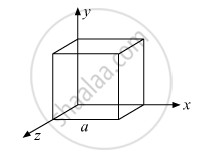Advertisements
Advertisements
प्रश्न
Given a uniform electric filed \[\vec{E} = 4 \times {10}^3 \ \hat{i} N/C\]. Find the flux of this field through a square of 5 cm on a side whose plane is parallel to the Y-Z plane. What would be the flux through the same square if the plane makes a 30° angle with the x-axis?
उत्तर
When the plane is parallel to the y-z plane:
\[\text { Electric flux }, \phi = \vec{E .} A^\rightharpoonup \]
\[\text { Here }: \]
\[ \vec{E} = 4 \times {10}^3 \ \hat{i} N/C\]
\[ A^\rightharpoonup = \left( 5 cm \right)^2 \ \hat{i} = 0 . 25 \times {10}^{- 2} \ \hat{i} m^2 \]
\[ \therefore \phi = \left( 4 \times {10}^3 \ \hat{i} \right) . \left( 25 \times {10}^{- 4} \ \hat{i} \right)\]
\[ \Rightarrow \phi = 10 \text { Weber }\]
When the plane makes a 30° angle with x-axis, the area vector makes a 60° angle with the x-axis.
\[\phi = \vec{E .} \vec{A} \]
\[ \Rightarrow \phi = EA \cos\theta\]
\[ \Rightarrow \phi = \left( 4 \times {10}^3 \right)\left( 25 \times {10}^{- 4} \right)\cos60°\]
\[ \Rightarrow \phi = \frac{10}{2}\]
\[ \Rightarrow \phi = 5 \text { Weber }\]
APPEARS IN
संबंधित प्रश्न
How does the electric flux due to a point charge enclosed by a spherical Gaussian surface get affected when its radius is increased?
Given the electric field in the region `vecE=2xhati`, find the net electric flux through the cube and the charge enclosed by it.

Two charges of magnitudes −3Q and + 2Q are located at points (a, 0) and (4a, 0) respectively. What is the electric flux due to these charges through a sphere of radius ‘5a’ with its centre at the origin?
It is said that any charge given to a conductor comes to its surface. Should all the protons come to the surface? Should all the electrons come to the surface? Should all the free electrons come to the surface?
If the flux of the electric field through a closed surface is zero,
(a) the electric field must be zero everywhere on the surface
(b) the electric field may be zero everywhere on the surface
(c) the charge inside the surface must be zero
(d) the charge in the vicinity of the surface must be zero
If the flux associated with a coil changes at the rate of 360 webers every 4 minutes, then the induced e.m.f. is ______
In a region of space having a uniform electric field E, a hemispherical bowl of radius r is placed. The electric flux Φ through the bowl is:
An electric charge q is placed at the center of a cube of side ℓ. The electric flux on one of its faces will be ______.
The S.I. unit of electric flux is ______
